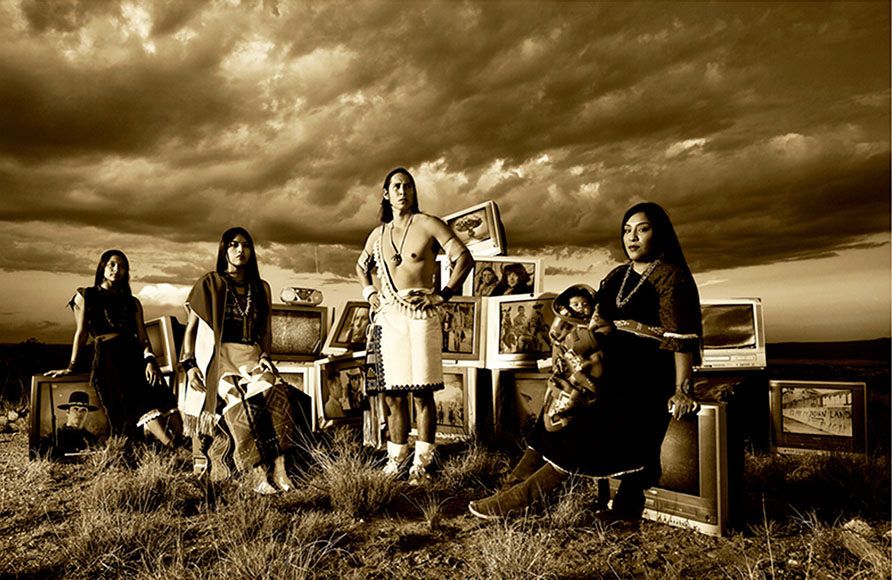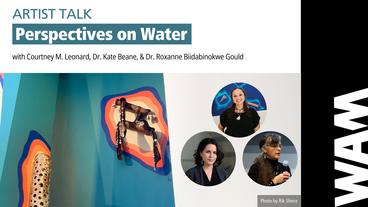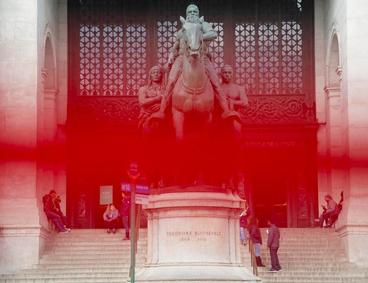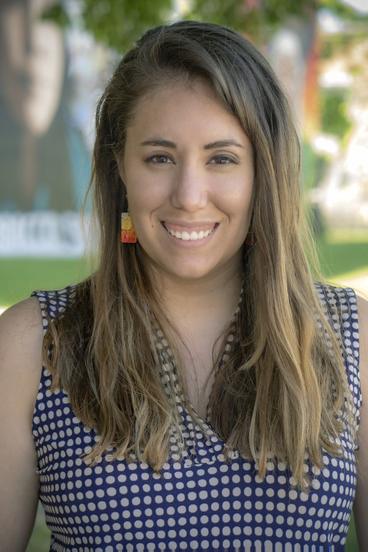At an accessions meeting at Weisman Art Museum (WAM) in December 2019, committee members voted to bring Cara Romero’s TV Indians into the permanent collection. With funds gifted by Russell Cowles, WAM purchased Romero’s striking photograph from the Bockley Gallery (Minneapolis, MN), where the work was on view for her solo exhibition, Jackrabbit & Cottontail, last fall. WAM is proud to provide a home for TV Indians, a deeply meaningful work and a significant addition to the museum’s collection of American art.
Born in 1977 in Inglewood, California, Romero grew up on the Chemehuevi Valley Indian reservation in the Mojave Desert and, later, in Houston, Texas. She first attended the University of Houston to study cultural anthropology, but quickly noticed that academic and media portrayals too often referred to Native American culture as if it were bygone and defunct—something that did not mirror Romero’s reality. Knowing firsthand the modern-day experiences of Indigenous peoples, Romero turned to photography by way of response, to visually present the lives of contemporary Native people. With degrees in studio art and photography, Romero now uses her formal training to create colorful, theatrical photographs that tell the stories of modern Indigenous people. Romero actively resists Eurocentric narratives and, instead, “fuses time-honored and culturally specific symbols with 21st-century ideas” to underscore the continuing vitality of contemporary Native Americans and affirm the persistent evolution and permanency of Indigenous cultures (Romero, “About,” Cara Romero Photography).
TV Indians exemplifies Romero’s narrative methods. The photograph shows Pueblo people situated in front of a wall of dated TVs. On the screens are widely-recognized images: scenes from Dances with Wolves; the famous WWII photo Raising the Flag on Iwo Jima, which features the Pima tribe’s Ira Hayes; a mushroom cloud, perhaps referencing nuclear bomb tests near Native American settlements in New Mexico. Each screen shows a media representation of Indigenous people. Some depictions are positive, but others are stereotypical or exploitative, recalling only suffering. Against this backdrop of conflicting images, the actual, present-day Pueblo people pictured in the foreground assert their existence and demand to be seen directly, rather than only through media representations.
The recent accession of TV Indians reaffirms WAM’s commitments to broaden the historically narrow definition of American art to include Indigenous works, to diversify current collections, and to proactively collect the art of women, people of color, and Indigenous peoples. (Of note: Romero’s husband, Cochiti Pueblo potter Diego Romero, is also represented in WAM’s collection.) Collecting and exhibiting both historical and contemporary Native American art is a long-held priority at WAM. Over the past 30 years, contemporary Native artists in WAM’s collection have been featured in exhibitions such as Shared Visions: Native American Painters and Sculptors in the 20th century (1991); Indian Humor (1997-98); Contemporary Native Art in Minnesota: The Work of Starr Big Bear, Julie Buffalohead, and Jim Denomie (2000); Better than the Picture of the Camera: Pueblo Indian Painting in New Mexico (2000); Tenuous, Though Real (2012; and Silver River (2016-17).
Since 2017, Romero’s TV Indians has been widely exhibited across the United States. “If there was ever a photograph of mine that needed to be seen large-scale to be appreciated, this is it,” Romero mentioned on her Instagram. Though TV Indians is not currently on view at WAM, the museum is thrilled to add Romero’s work to the collection and looks forward to the future possibilities of making this significant and meaningful photograph available to the public.
Sources
“Bockley Gallery: Exhibitions.” Bockley Gallery :: Exhibitions, Bockley Gallery, 2019, www.bockleygallery.com/exhibitions.html.
Jim Denomie, Native Art, 2000, Box: 203. Frederick R. Weisman Art Museum records, ua-00004. University Archives. https://archives.lib.umn.edu/repositories/14/archival_objects/247772 Accessed March 15, 2020.
Julie Buffalohead, Native Art, 2000, Box: 203. Frederick R. Weisman Art Museum records, ua-00004. University Archives. https://archives.lib.umn.edu/repositories/14/archival_objects/247773 Accessed March 15, 2020.
Listening with the Heart, Contemporary Native Art, circa 2000s, Box: 192. Frederick R. Weisman Art Museum records, ua-00004. University Archives. https://archives.lib.umn.edu/repositories/14/archival_objects/247365 Accessed March 15, 2020.
Local Native American Show, 2000, Box: 203. Frederick R. Weisman Art Museum records, ua-00004. University Archives. https://archives.lib.umn.edu/repositories/14/archival_objects/247771 Accessed March 15, 2020.
Romero, Cara. “About.” Cara Romero Photography, 2019, www.cararomerophotography.com/about.
Romero, Cara. “‘TV Indians’, edition 1/7, 2017, 42”H X 61”W.” Instagram, additional description by @abqjournal, 3 Jun. 2018, https://www.instagram.com/p/BjlTmyOgJSC/.




